Key points
During the 1950s and 1960s, the civil rights movement made significant progress.
The work of people like Claudette Colvin, Rosa Parks, Dr Martin Luther King Jr and Malcolm X led to the passing of civil rights acts and Supreme Court rulings to end segregation. These judgments aimed to prevent discrimination against Black Americans.
Martin Luther King and Malcolm X had different ideas about how to achieve change, and what type of change they wanted.
Video about the civil rights movement
Narrator:
The ongoing struggle in America for racial equality has its roots in the trade of enslaved people, the Civil War and the abolition of slavery. The civil rights movement of the 1950s and 1960s was an important period of political action. It was a movement led by people from all over the country, all fighting racism in local ways, creating a powerful national movement.
Families, students, pensioners, young and old rising up for what they believed in, fairness, equality, freedom and challenging hatred, prejudice and racism across America. Claudette Colvin and Rosa Parks refusing to give up their seats on buses when white people demanded them, leading to the Montgomery bus boycott and the banning of segregated buses in Alabama.
Ruby Bridges and the Little Rock Nine being amongst the first Black children to attend schools that had previously been whites only. The Greensboro Four sparking sit-ins across the country in whites only areas in restaurants and cafes. Leaders such as Martin Luther King Jr. brought people together with powerful words like his вҖҳI Have a DreamвҖҷ speech delivered in Washington, inspiring hope for a more equal future.
The 54 mile long March, over five days from Selma to Montgomery, was a cry for action from people desperate for change and justice. Leaders like Malcolm X, who were more radical and more militant, promoted Black Power. They argued that Black Americans should focus on creating economic, social and political power of their own. Slowly, as a result of these key events, ideas and movements, change and progress was made.
There were victories in court and civil rights laws were passed, giving Black Americans the same civil rights as white Americans. But racism continued. Some people still opposed equal rights. Many activists were killed in counter-protests, riots and assassinations. Malcolm X was assassinated in 1965 and Martin Luther King Jr. was assassinated in 1968.
The campaigns of the 1950s and 60s werenвҖҷt the end of the journey, but it was a pivotal moment in the ongoing struggle for equality, justice and freedom for all.
Who took action during the civil rights movement?
Many people in the civil rights movement made use of direct action to try and achieve their aims for equality.
Direct action is a form of public protest that includes lots of different methods, such as marches, boycottA refusal to buy goods or services from a person or organisation as a form of punishment or protest., strikes, sit-inA form of protest that involves people sitting on the seats or floor of a place, and refusing to leave until their demands are met. and demonstrations. Members of the civil rights movement took direct action in the hope that it would draw peopleвҖҷs attention to their struggle for equality, and have an impact that people in power could not ignore.
Throughout the 1950s and 60s, ordinary people from all over the US undertook lots of different kinds of protest and action to demand equality and an end to racist segregationThe enforced separation of different racial or ethnic groups by providing separate public services and facilities, such as schools, libraries and waiting rooms. laws.
Scroll through the images below to learn about some of the actions taken by ordinary people.
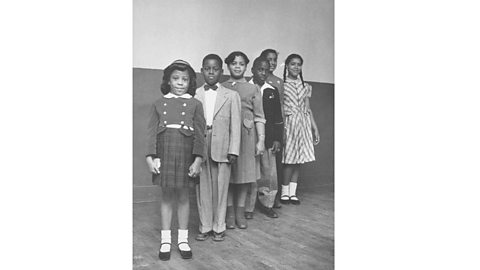
Image caption, In 1951, a group of Black parents from Kansas brought a legal case to challenge laws that meant their children were not allowed to attend schools with their white peers. This became known as the Brown v. Board of Education case. It led to a Supreme Court ruling in 1954, which declared segregated schools to be unequal.
Image caption, In 1957, nine Black students in Little Rock, Arkansas, attended a school intended for white children. They needed protection from the military as they made their way to school, as many people were violently opposed to allowing Black children to attend school alongside white children.
Image caption, In 1960, Black students held sit-ins at вҖҳwhiteвҖҷ restaurants. One of the most famous examples of this action was the вҖҳGreensboro FourвҖҷ, whose action resulted in a department store ending its policy of segregation in the southern states of the USA. Sit-ins were held across several southern states, and by 1961, it is estimated that over 70,000 people had taken part.
Image caption, In 1963, in Birmingham, Alabama, activists began a boycott of shops and businesses that enforced segregation rules. This had a big financial impact on businesses in the city. There were also sit-ins in segregated libraries and restaurants across the city. Police were brutal in their attempts to suppress the protests.
1 of 4
How important were the actions of ordinary Americans during the civil rights movement?
The actions of ordinary people were very important in helping to bring segregation rules to an end, and in passing key laws to protect the rights of Black Americans.
Leaders of the civil rights movement, particularly Martin Luther King, believed strongly that the actions of ordinary people were key in the struggle for equality for Black Americans.
Civil rights acts
The Civil Rights Act was passed by President Lyndon B. Johnson in 1964. It continued the work of President John F. Kennedy after his assassination.
The Civil Rights Act made it illegal for someone to be discriminated against in the workplace on the basis of their skin colour. Segregation in public spaces, such as parks and cinemas, was also banned. The 1965 Voting Rights Act outlawed discriminationTreating people differently on the basis of a particular characteristic, such as race, religion or sex. that prevented Black Americans from voting. It banned the requirement for a literacy test.
In 1968, President Johnson signed a further Civil Rights Act, a week after Martin Luther KingвҖҷs assassination. Also known as the Fair Housing Act, this banned discrimination in owning or renting houses on the basis of race.
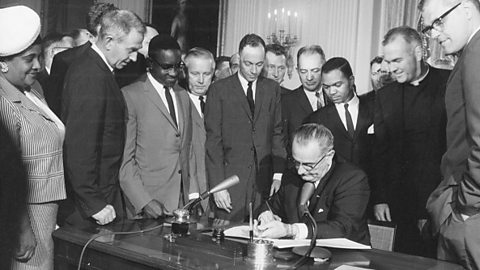
Bus boycotts
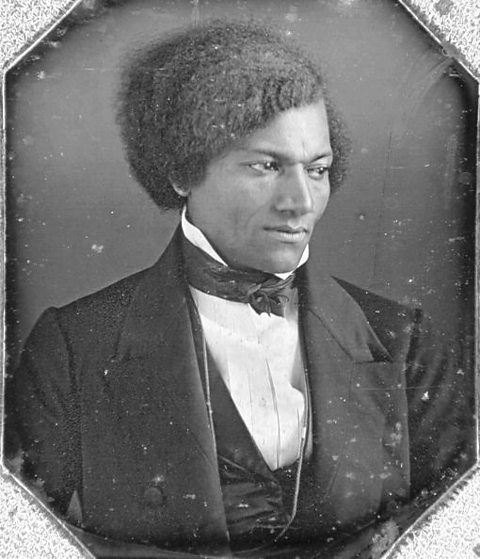
Protests and boycotts on buses and other forms of public transport played a significant role in the civil rights movement, with many Black Americans taking a stand against the discrimination they faced.
In the 1800s, Frederick Douglass, who had been enslaved and later campaigned for the abolition of the transatlantic slave trade, sat in a train carriage intended only for white passengers, and refused to move.
DouglassвҖҷ actions inspired other civil rights activists to take similar action.

Claudette Colvin
In March 1955, Claudette Colvin was on her way home from school when she refused to give up her seat for a white passenger on a bus in Montgomery, Alabama. This was against AlabamaвҖҷs state laws. At this time, seats on buses were segregated. When the seats for white people were full and there was only room for people to stand up, Black Americans were expected to give up their seats for white passengers. As ColvinвҖҷs bus began to fill up, the driver asked her and another Black woman, who was pregnant, to stand up, but Colvin refused to do so. The driver called the police, and Colvin was arrested. She was later put on trial and found guilty of breaking the segregation laws.
Rosa Parks and the Montgomery bus boycott
Scroll through the images below to learn about the actions of Rosa Parks, and how the Montgomery bus boycott helped end segregation on buses.
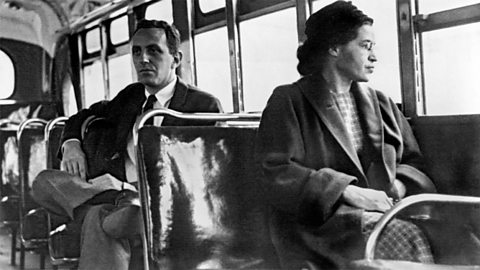
Image caption, Nine months later, on 1 December 1955, also in Montgomery, Rosa Parks was sitting in the seats intended for Black passengers when she refused to give up her seat for a white passenger.
Image caption, Rosa was arrested for her actions. She was fined a total of $14 in court, and later lost her job in a department store.
Image caption, The National Association for the Advancement of Colored People used her case to challenge segregation on buses. Along with Parks, they organised a bus boycott in Montgomery, during which Black people didnвҖҷt use the buses for over a year. This lasted from 5 December 1955 to 20 December 1956. Instead of using the buses, people walked to work and Black Americans with cars gave people lifts.
Image caption, In November 1956, the Supreme Court ruled that the bus segregation was unconstitutional. The boycott had been hugely effective because it had a big financial impact on the bus service. Black Americans made use of their collective economic power to bring segregation on buses to an end.
1 of 4
What was the Baton Rouge bus boycott?
Claudette Colvin and Rosa Parks were not the first people to undertake boycotts on buses. By the 1950s, bus boycotts had become an important form of direct action across the US.
The first major boycott of segregation on buses took place in Baton Rouge, Louisiana, in 1953. The boycott was partly a result of the Baton Rouge City CouncilвҖҷs decision, in 1950, to support white-owned bus companies that were struggling for money by taking away the licenses of the cityвҖҷs Black-owned companies. This meant that Black Americans, who made up 80% of the cityвҖҷs bus passengers, were forced to travel on segregated buses. They had to sit at the back of the bus or stand up, even if the seats reserved for white people stayed empty. Then, in January 1953, bus fares were raised. A local pastorA person such as a minister or priest, who is in charge of a church., T. J. Jemison, complained to the city council. They responded by introducing a rule called вҖҳOrdinance 222вҖҷ. This allowed Black passengers to sit in вҖҳwhiteвҖҷ seats if they were available, but Black Americans were still not allowed to sit next to white passengers, or in front of them.
The new rule was opposed by many white-owned bus companies, and two drivers were suspended for refusing to obey it. This led to a four-day strike by the white bus driversвҖҷ union. Officials in Louisiana responded by overturning Ordinance 222, and the white bus drivers went back to work. In response, Black Americans boycotted the buses by standing at bus stops and turning their backs as the buses drove past. Black vehicle owners gave each other lifts to and from work, and 7,000 people attended a meeting in support of the boycott.
The bus companies were very worried about the financial impact of the boycott. As a result, they held a meeting with the city council and T. J. Jemison. This led to a new rule, вҖҳOrdinance 251вҖҷ, which reduced the number of вҖҳwhiteвҖҷ seats on buses, but Black passengers still had to sit behind white travellers, and they would also have to stand up if the вҖҳwhiteвҖҷ seats were available. Even though the boycott did not end segregated buses, it showed the power of direct action.
Dr Martin Luther King Jr
Dr Martin Luther King Jr was a Christian Baptist minister and a leading member of the civil rights movement. In 1955, he became well-known as a leader of the Montgomery bus boycott. He gave people lifts in his car and was sent to prison for two weeks for his role in the protest.
King believed that non-violent direct action was the best approach to pressuring the government for civil rights reforms. As well as the bus boycott, King supported a number of different direct action protests during the civil rights movement, including:
Sit-ins by students who were protesting against discrimination in universities
Peaceful protest marches
Delivering speeches in public
In 1963, King led the Washington March for Jobs and Freedom. He stood in front of the Lincoln Memorial in Washington D.C. and delivered his famous вҖҳI Have a DreamвҖҷ speech to a crowd of 250,000 people. Many historians believe that this speech played a key part in pressuring the government to pass the Civil Rights Act of 1964. He was awarded the Nobel Peace Prize in 1964 for his civil rights work.
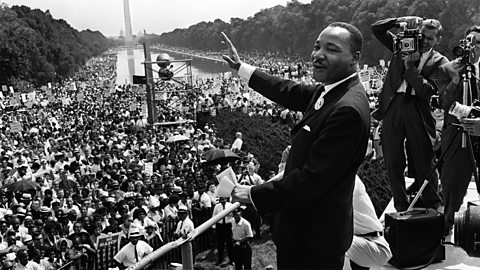
In March 1965, King helped to organise 54-mile protest marches from Selma to Montgomery, Alabama, to try and ease voting restrictions on Black Americans in southern states. This helped to raise awareness of voting issues and pressured the government into passing the Voting Rights Act later that year.
In April 1968, King travelled to Memphis to support striking workers. On 4 April 1968, King was assassinated on his hotel balcony.
In recognition of the role he played in the civil rights movement, Martin Luther King Day was introduced in the USA in 1971. It is held every year, on the third Monday in January, to commemorate his birthday.
Activity - Put the events in order
Malcolm X
Not everyone supported Martin Luther KingвҖҷs peaceful protest methods. Malcolm X campaigned for civil rights through speeches and protests, but also believed that it may sometimes be necessary to use violence as part of the campaign.
As a child, Malcolm and his family were targeted by the KKK and suffered racist abuse. His father was killed in a car accident, in what some historians believe was a racist attack. Having struggled to find a secure job, Malcolm became involved in crime, and was sent to prison for robbery in 1946. During his time in prison, Malcolm converted to Islam. On his release from prison in 1952, Malcolm joined an organisation called the Nation of Islam, which was led by a man named Elijah Muhammad. This group believed in black nationalism, which argues that Black people should create social, economic and political power of their own.
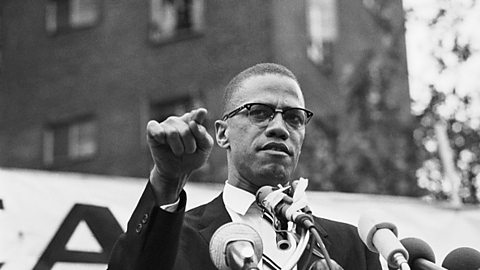
In April 1964, Malcolm made his most famous speech, вҖҳThe Ballot or the BulletвҖҷ. He made demands for Black people to be able to govern their own communities and stated that violence could be used if their demands werenвҖҷt met.
Following a series of disagreements, Malcolm left the Nation of Islam in 1964, though he remained a Muslim. In February 1965, Malcolm was assassinated. Historians do not know the identities of all of those who were responsible for MalcolmвҖҷs murder. In 1966, three men known at the time as Thomas Hagan, Norman 3X Butler and Thomas 15X Johnson were convicted of MalcolmвҖҷs murder and sentenced to life imprisonment. Butler and Johnson were exoneratedWhen someone is convicted of a crime, but it is later found that they were not to blame. in November 2021.
What were the differences between Martin Luther KingвҖҷs and Malcolm XвҖҷs approaches to the civil rights movement?
Although Martin Luther King and Malcolm X were both civil rights activists, the tactics they used in their fight for equality were very different.
King believed that non-violent protests were the most effective way to fight against segregation. He led many protests across the US. Malcolm X rejected KingвҖҷs ideas and believed that Black Americans had the right to equality вҖҳby any means necessaryвҖҷ. He felt that violence was sometimes needed as part of the campaign.
The Black Power movement
Malcolm XвҖҷs ideas had a big influence on the Black Power movement, which was a civil rights protest movement that began in the later 1960s. Its members believed in racial pride and social equality. The movement advocated for economic freedom and independence and Black Americans showed pride in their African heritage by wearing African clothing.
One of the key leaders in the Black Power movement was Stokely Carmichael, who later became known as Kwame Ture. In 1960, he had joined the newly-formed Student Non-violent Co-ordinating Committee (SNCC). However, by the mid-1960s, he and other activists were becoming frustrated at what they saw as the slow progress that could be achieved by using non-violent methods. Members of the Black Power movement believed that, if they were violently attacked by those who opposed the civil rights movement, they were justified in responding with violence.
In 1966, Carmichael was elected as chair of the SNCC. Not long after, he used the phrase вҖҳBlack PowerвҖҷ for the first time, when he led a crowd though Greenwood, Mississippi, chanting вҖҳwe want Black Power!вҖҷ
Test your knowledge
Play the History Detectives game! gamePlay the History Detectives game!
Analyse and evaluate evidence to uncover some of historyвҖҷs burning questions in this game.

More on The civil rights movement in America
Find out more by working through a topic
- count1 of 2
